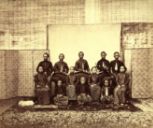Badan
The wax in the upper edge of the batik has been thickened. In the badan, the largest surface of the sarong, we can clearly recognize the parang motif. Parang is an umbrella term for a certain type of batik motifs that only vary a little in size and details. The smallest part of the pattern looks like a knife, or a machete, which is called parang – hence the name. The repeated motif is always printed in diagonal strokes, which is called lereng. Parang also belongs to the larangan motifs. These are forbidden motifs that were only worn in the past by the rulers of Java, the sultans and their families. Not all forms of parang fell under this interdiction, which was introduced mostly to prevent people from wearing this motif outside of the kraton, the regal palace. The parang motif was and still is used and worn so often that it has become one of the most famous batik motifs from Indonesia.
The batik was, as we see in this cloth, ready for the next stage: a bath of indigo dye.

